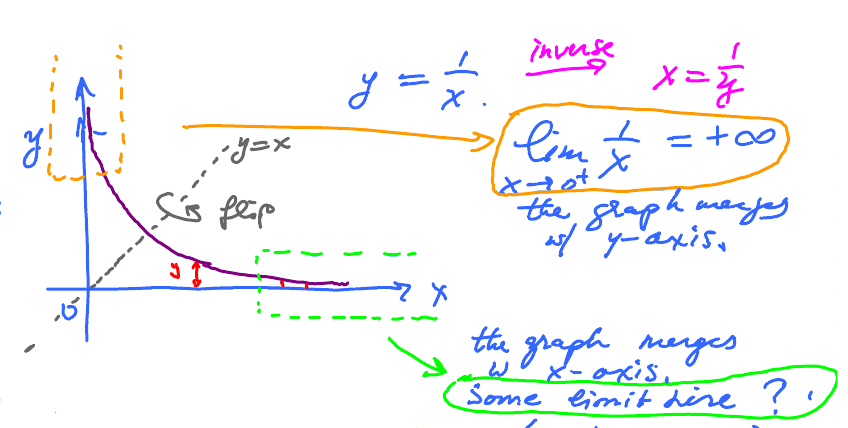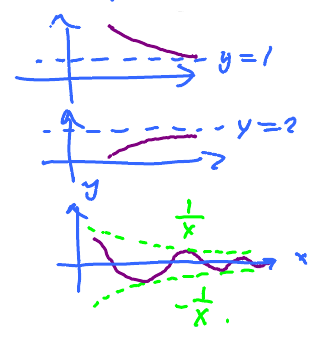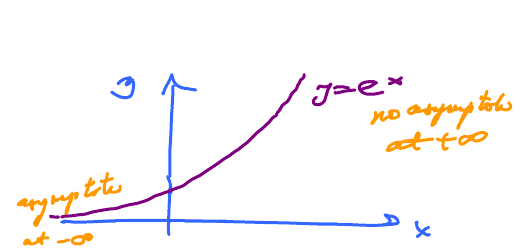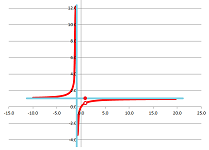This site is being phased out.
Limits at infinity: part 1
"A limit at infinity"
Given $$ y = f(x) $$
Note: Not the same as "infinite limits"
- "Infinite limit" means that $y \to \infty$.
- "Limit at infinity" means that $x \to \infty$.
There are similarities however.
Let's compare.
Consider what happens when we take the inverse of a function.
Compare what is happening:
- $\color{orange} x \to 0^{+} \quad y \to +\infty $
- $\color{green} y \to 0^{+} \quad x \to +\infty$
Rewrite the second one $$\lim_{x \to +\infty}\frac{1}{x} = 0 $$ a limit at $\infty$, i.e. $x$ approaches $\infty$.
Notation similar to the old $$\lim_{x \to 1} \frac{1}{x} = 1 $$ "$x$" approaches 1. What is the main difference?
- $\lim\limits_{x \to a}$, a number, is about the local/short term behavior of the function.\
- $\lim\limits_{x \to \infty}$, is about the long term behavior.
Example. Recall the gravitational force:
$$F = \gamma \frac{m_{1} m_{2}}{d^{2}},$$
where $m_{1}$, $m_{2}$ are masses of the two objects and $d$ is distance between them.
Let $d$ be the variable. Then $$ \lim_{d \to \infty} F = 0.$$ This means that the force becomes negligible as you move away.
Numerical comparison:
| $x$ | 1 | 10 | 100 | 1000 | 10,000 | $\rightarrow$ | $\infty$ |
|---|---|---|---|---|---|---|---|
| $\frac{1}{x}$ | 1 | 0.1 | 0.01 | 0.001 | 0.0001 | $\rightarrow$ | 0 |
Graphical comparison:
Let's make this more precise the geometry behind this algebra.
Definition. Suppose $$\lim_{x \to \infty} f(x) = L,$$ then we say that $y = L$ is a horizontal asymptote.
Remember this is a straight line.
Suppose $f$ is one-to-one and $y = L$ is its horizontal asymptote.
- Question
- What about $f^{-1}$?
- Answer
- $ y = L$ is a vertical asymptote of $x = f^{-1}(y)$.
And vice versa!
Example. Very simple... $$\begin{gathered} \lim_{x \to \infty} \left(1 + \frac{1}{x}\right) = 1 \\ \lim_{x \to +\infty} \left(2 - \frac{1}{x}\right) = 2 \\ \lim_{x \to +\infty} \frac{1}{x}\cos x = 0 \end{gathered}$$
Summary:
Example. Given $$\begin{gathered} f(x) = e^{x} \\ \lim_{x \to \infty} e^{x} = ? \\ \lim_{x \to -\infty} e^{x} = 0 \\ \lim_{x \to +\infty} e^{x} = +\infty \end{gathered}$$
Graphically:
Recall the possible outcomes for a limit at a point: $$\lim_{x \to a} f(x) = \begin{cases} \text{ exists, } L \text{ a number} \\ \infty \\ \text{ does not exist (even as } \infty) \end{cases}$$ Same for: $$\lim_{x \to \pm\infty} f(x) $$
Example. $$\lim_{x \to \infty} \cos x $$ does not exist. Why?
Informally, we say that no single value $L$ is approached by the value $f(x)$ function as $x$ approaches $\infty$.
Fact: All rules of limits hold for limits at $\infty$.
Recall that $f$ is continuous at $x=a$ if $\lim\limits_{x \to a} f(x) = f(a)$. (Definition)
To prove discontinuity, show the opposite: $$ \lim_{x\to a} f(x) \neq f(a) $$ Three possibilities:
- $\lim\limits_{x\to a} f(x)$ does not exist.
- $f(a)$ is not defined.
- They are not equal.
Example. Let's fully investigate this function: $$f(x) = \begin{cases} \frac{x^{2} - x}{x^{2} - 1} & \text{ if } x \neq 1 \\ 1 & \text{ if } x = 1 \end{cases}$$
- Is $f(1)$ defined? Yes, $f(1) = 1$
- Does the limit exist? Let's compute it.
$$\lim_{x\to 1} f(x) = \lim_{x \to 1} \frac{x^{2} - x}{x^{2} - 1}$$ Plug in $x=1$. $$\frac{1^{1} - 1}{1^{2} - 1} = \frac{0}{0}$$ Indeterminate!
So, we need to do algebra before limit.
$$\begin{aligned} \lim_{x \to 1} \frac{x^{2} - x}{x^{2} - 1} & = \lim_{x \to 1} \frac{x(x-1)}{(x-1)(x+1)} \\ & = \lim_{x \to 1} \frac{x}{x+1} \\ &= \frac{1}{1 + 1} = \frac{1}{2} \end{aligned}$$ Note that $\frac{x}{x+1}$ is rational and continuous on its domain
Are the limits equal?
No. $1 \neq \frac{1}{2}$. That's why the function is discontinuous at this point (removable).
Formula: $$f(x) = \begin{cases} \frac{x}{x+1} & \text{ if } x \neq 1 \\ 1 & \text{ if } x = 1 \end{cases}$$
Find the domain: $$\begin{aligned} x + 1 & \neq 0 \\ x \neq 1 \end{aligned}$$
Domain: $$(-\infty,-1) \cup(-1,\infty)$$
Consider $\frac{x}{x+1}$ at $x=-1$: $$\lim\limits_{x \to -1}\frac{x}{x+1}$$ is infinite $(=\infty)$, so $x=-1$ is a vertical asymptote.
However there are still 4 distinct possibilities of how the graph approaches the asymptote.
To tell which one, compute the one-sided limits: $$\begin{aligned} \lim_{x \to -1^{-}} \frac{x}{x+1} \left( = \frac{-}{-} = + \right) & = +\infty \\ \lim_{x \to -1^{+}} \frac{x}{x+1} \left( = \frac{-}{+} = - \right) & = -\infty \end{aligned}$$
Next, behavior at $\infty$. $$\lim_{x \to \infty} f(x) = \lim_{x \to \infty} \frac{x}{x+1} = 1 \gets \frac{1000000}{1000001} \text{ informally}$$ So $y=1$ is a horizontal asymptote.
Finally, plot it:
$\square$
This was: Algebra $\rightarrow$ Graph
Sometimes: Graph $\rightarrow$ Algebra (later)
Q: Can the graph of a function cross its own asymptote?
That's $ \frac{1}{x}\cos x$.
A: Yes.
Proceed to Limits at infinity: part 2.






